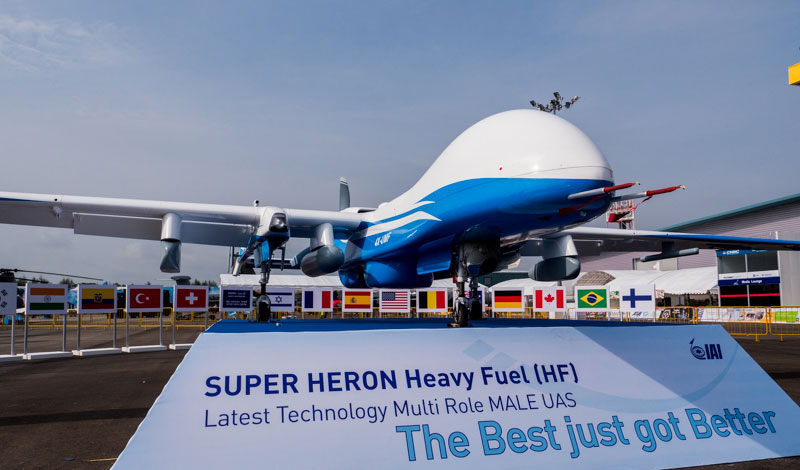
Unmanned Systems
India is operating Israeli UAVs since the first delivery of IAI Searcher IIs in 1996. The larger Heron I was publicly displayed in New Delhi in 2003. Additional systems were ordered in 2013 and more to be fielded soon. India was mentioned as one of the operators of Israel’s loitering munitions, UAV-based Harpy (counter-radar weapon) and Harop (a loitering weapon equipped with electro-optical targeting system. Today, India is believed to be the largest UAV operator outside the USA. With the ever-growing Indian appetite for drones, new prospects are opening, attracting more Israeli UAV producers like Elbit Systems, as well as many international providers from Europe and the USA. At Aero India IAI is highlighting two of its latest variants – a larger version of Heron I, designed with more spacious payload bay, enabling the integration of more complex mission systems, and the Super Heron, equipped with heavy fuel engine, a version designed for use primarily by the Army and Navy. IAI competitor Elbit Systems is also offering the Hermes 900, which proved highly successful competing against the Heron in the Israeli and overseas markets.
Other UAVs offered here are the unique Panther tilt-rotor drones, designed for operation from densely vegetated terrain or naval platforms. Other opportunities for drones would require the ability of operations from high altitude and remote locations, in support of the new Mountain Strike Corps to be deployed along the Himalayan border with China. As these units are required to become self sufficient with surveillance and intelligence gathering, the deployment of unmanned platforms in support of echelons from corps and below would be needed. Such systems could include Medium Altitude Long Endurance (MALE) drones such as the Super Heron or Hermes 900 HFE, and smaller, electrically powered drones supporting brigades and battalions with ad-hoc intelligence. Delivering such requirements, several UAV manufacturers in Israel have come up with enhanced electrically powered mini-drones and tactical aerostats that have evolved to support longer missions and heavier payloads.
Training systems and services has been another growth area for Israeli companies in India. One of the leaders in this field is Elbit Systems, offering a comprehensive training system for the Indian military. To pursue this opportunity Elbit Systems and Indian aerospace prime HAL have formed a joint venture specializing in training system. The model for this JV has been demonstrated as highly successful and efficient with the Israel Air Force and with other customers abroad. Elbit is supporting major Israel Air Force training programs, by maintaining and operating the Grob-120, T-6B and M-356 and helicopter trainer fleet, as well as part of the air combat instrumentation systems (ACMI) using EHUD system. The company also provides comprehensive simulation services based on ‘fly by the hour’. In the future, the company will also integrate virtual avionics to enhance flight training integrating actual training missions with ground-based simulation into a cohesive, productive training system. The Elbit Systems-HAL JV is positioned to convince the IAF to deploy a similar system, although at a much larger scale.
With openness and willingness to expand its cooperation with New Delhi, Israel-India defense relations could enter a new era of defense cooperation, if both sides will play their cards right. Too much eagerness could backfire. Overly protective policy would miss the window of opportunity that ‘Make in India’ policy has opened, promising to turn local enterprises into industrial and support basis for the military.













